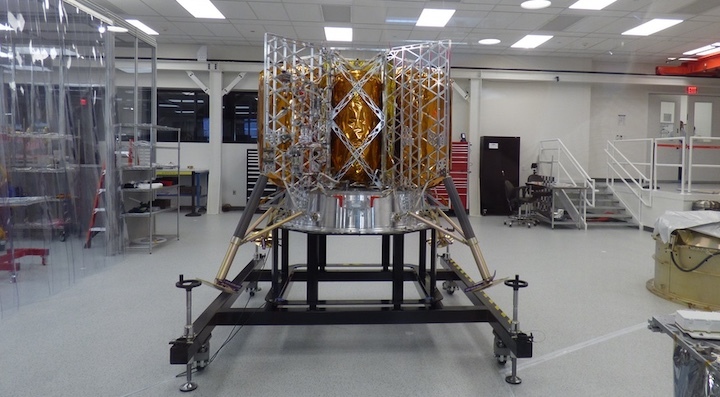22.04.2022

Astrobotic's Peregrine lander, in the latter phases of assembly, is on track to launch by the end of the year, the company said April 20. Credit: SpaceNews/Jeff Foust
PITTSBURGH — Astrobotic Technology showed off its nearly complete lunar lander it is building for NASA’s Commercial Lunar Payload Services (CLPS) program and said the spacecraft remains on schedule to launch this year.
At an event as its headquarters here April 20, attended by NASA Administrator Bill Nelson and other agency officials, the company showed its Peregrine lander that it plans to send to the moon on the first United Launch Alliance Vulcan Centaur launch in late 2022.
The lander is still being assembled, said John Thornton, chief executive of Astrobotic. Remaining work includes installation of its solar panels, two fuel tanks and decks holding payloads. The engines are “just about done,” he said, and will soon be installed.
He was optimistic that remaining work will be done quickly. “In just a couple months’ time, this will be heading out to environmental testing,” he said, followed by shipment to the launch site late this year.
Astrobotic expects Peregrine to launch in the fourth quarter of this year, a schedule that depends on both the readiness of the lander and Vulcan. “Things are on track for a flight in Q4 of this year,” he said during a speech earlier in the day at a conference by the Keystone Space Collaborative, a regional space industry group, citing updates he received from ULA about their progress on Vulcan. “As far as we know, they’re on track for the end of the year.”
Astrobotic will be carrying both NASA payloads through its CLPS program as well as commercial payloads. Seven countries, including the U.S., will have payloads on the lander, Thornton said.
He billed Peregrine as NASA’s return to the lunar surface after half a century. “This is our nation’s first lander headed back to the surface of the moon, nearly 50 years since Apollo,” he said.
Peregrine is, in fact, one of two commercial landers in development for launch in the next year, with Intuitive Machines working on its Nova-C lander for the IM-1 mission, also part of CLPS. That company previously said IM-1 would launch later this year but hasn’t provided a specific date.

Astrobotic CEO John Thornton unveils the Peregrine flight model April 20 at the company’s Pittsburgh headquarters. Credit: SpaceNews/Jeff Foust
Peregrine is also a pathfinder for a much larger lander, Griffin, that Astrobotic is building to deliver NASA’s VIPER rover to the south pole of the moon in late 2023. “This is very important, because their next one that’s going in ’23 is going to be us landing on the south pole of the moon where the resources are, where water is,” Nelson said at the event.
“It’s a monster,” Thornton said of Griffin, nearly five meters in diameter and capable of delivering 500 kilograms of payload to the lunar surface. “It’s the largest lander of any kind since Apollo.”
First, though, Peregrine must make it to the moon. NASA established the CLPS program with a “shots on goal” mindset, accepting that some fraction of the missions will fail to land. Only NASA, the former Soviet Union and China have successfully landed on the moon, with recent attempts by India’s space agency ISRO and SpaceIL, a privately funded Israeli group, ending in failure.
“Pretty soon we’ll be sitting here, chewing off our fingernails, hoping and trusting everything will go just fine,” said Thomas Zurbuchen, NASA associate administrator for science and a leading advocate for the CLPS program. Peregrine, he said, will carry versions of instruments that will also be flown on VIPER, testing them ahead of that mission.
“We can try them in the right environment. We can develop them faster,” he said of the instruments, keeping instrument development off the critical path for the later mission. “Everybody looks at the lander. I look at the payload.”
Quelle: SN
